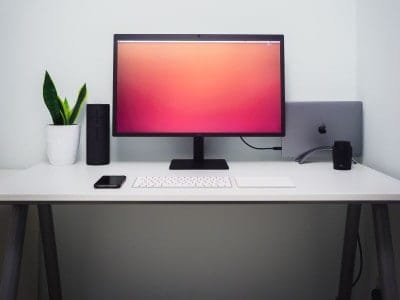We have all been warned about the risks of sitting for long periods of time. Due to this, everybody, including employers, start to look for ways to prevent prolonged sitting and encourage a healthier lifestyle.
To encourage movement and prevent stationary workplace health concerns, the idea of raising the desks has become the most viable option.
Now, standing desks have become the current trend in our modern world.
Just like any other inventions, standing desks come with their pros and cons.
The Pros

Standing desks allow you to move freely while staying focused on your tasks.
Standing desks have gained popularity over the last few years. This is because experts believe standing up more offers health benefits and helps people to become active.
▪️ Encourages movement
When you are standing while working, you tend to respond to your body faster than when you are sitting.
Also, when you are using a standing desk, you can move freely. Giving you more opportunity to move your feet, your body, and do some simple stretching.
▪️ Increase in productivity
When you are using a standing desk, you tend to be more alert and focused. Therefore, you get to complete more tasks compared to when you are sitting.
Sitting makes you feel too comfortable and sluggish which, in turn, affects your productivity.
▪️ Helps improve posture

When you stand and focus on your posture, you will be in an upright position.
Concentrate on lengthening your spine. This will help your spine to straighten which will help you avoid many other health problems.
Proper posture is not just about the way you look. Improper posture can affect your bone strength, leaving you hunched or disfigured which can lead to pain and loss of confidence.
Standing helps keep your spine upright, which results in less pain on the shoulders, neck, and lower back.
▪️ Helps lower blood glucose levels
According to a study conducted in 2014, using standing desks at work helps reduce blood spike by 43%.
The study shows there was a reduction in the blood spike among the participants and it is caused entirely by standing and not because of any extra physical activities.
This is a great health benefit especially for those with Type II Diabetes.
▪️ Better blood circulation
When you are standing, blood flows freely in your body. This results in better oxygenation which leads to better focus, alertness, and a higher level of energy.
Better oxygenation means your brain functions better so you can complete your tasks faster than when you are sitting.
Better blood flow also means better immunity. This means your body has a higher chance of shielding you from diseases.
▪️ Lower risk of weight gain and obesity
Although standing is not necessarily beneficial to weight loss, it does help burn a little bit more calories than when you are sitting.
The extra calories burned help prevent your body from gaining more weight which helps lower your risk of obesity.
Furthermore, using a standing desk gives you more room to move freely, allowing you to stretch, walk a few steps, or even dance without going too far from your workstation.
▪️ Less Clutter

A standing desk has enough surface area for your laptop, mouse, and keyboard.
This is plenty of room for your essentials to get your work done.
Less stuff on your desk creates less distractions.
As a result, you have a clutter-free desk. A clean, well-organized workspace is good for your mood and productivity.
The Cons
Here are the disadvantages I have discovered about standing desks:
▪️ Limited space

- They are not designed to become cluttered work stations.
- No storage space
- I only saw one that has even a tiny drawer
- The one with the drawer was very expensive
- Too much standing is also not good for you
▪️ Too much standing can cause health issues
Just like sitting for a long time, standing in one place for too long can also cause health issues.
If you stand in one position for too long without any movement, it can cause your blood to pool in your legs which can lead to fatigue, varicose veins, and sore feet.
Prolonged standing can also cause pain in your lower back, legs, and feet.
How Can You Maximize Your Standing Desk
Standing offers more health benefits than sitting. However, if not done properly, can also cause health issues.
To make sure you get the maximum benefits out of your standing desk and minimize the harmful effects of standing, follow these tips:
1.Choose a standing desk that is appropriate for your height.

If you plan to use an adjustable standing desk, make sure to check the minimum and maximum height it allows. Check if it is appropriate for your height.
- Stand straight in front of the standing desk. Your neck should be neutral, shoulders back, and arms on your side.
- Place your elbows on the surface of the desk. Make a 90-degree angle.
- Your elbow must be able to rest comfortably on the desk and your wrist should be neutral.
- Your neck should also remain neutral and you should be able to stay in your upright position. If not, the height is not good for you.
You can either adjust the height of the standing desk or find a new one that fits your height.
2.Position your screen or monitor
To ensure that you have good posture at all times, make sure your monitor is in the proper position.
If your screen is too far or too near from your face, it can cause eye strain which can lead to several eye conditions.

To measure the proper distance of your monitor from your eye, follow these steps:
1.Stand straight in front of your monitor.
2. Touch the top of your screen with the tip of your middle finger.
3. The distance between the tip of your middle finger to your elbow is how far your screen should be from your eyes.
4. Slightly tilt the top of your screen. The idea is for the tip of your screen to be at your eye level. This should prevent eye strain and will give you a better view of your screen.
What you are aiming for is for your neck to remain neutral and you should not be moving your neck up and down when using your computer.
3. Consider the size and depth of your standing desk when buying
Standing desks come in different designs, shapes, and sizes. It is important that you consider how wide your workspace is and what things you will put on your desk.
- Measure your laptop.
- Measure your monitor.
- Make sure to measure the depth of your monitor too.
- Check the sizes of the desks I recommend on my resources page, click here.
If you have a small workspace, choose a standing desk with a sleek design. You may need to use separate storage for your other work items.
You can take advantage of the space at the bottom of the desk.

If you already have an existing desk and you don’t want to get rid of it, you can use a desk riser or desk converter.
A desk converter can be rather bulky and the design may not suit the theme of your workplace but it’s a great substitute for a standing desk.
4. Alternate from standing to sitting.
Standing for too long in one position is bad for your health.
The purpose of a standing desk is to keep you away from a sedentary lifestyle. Therefore, you should move.
Just because you are using a standing desk does not mean you should not sit anymore. You have to sit, but sparingly.
The key to maximizing the benefits of a standing desk is to move from time to time.
I like to use a desk timer like Pomodoro timer to remind me when it is time to stretch or take a brisk walk. Now
I also choose to listen to my body. When I feel a sensation on my feet, legs, or arms I stretch a bit, walk a few steps from side to side and back and forth, then sit for 10 to 15 minutes before I go back to standing again.
I feel so much more alert and energized after stretching.
I can focus more and be more productive.
5.Wear comfortable shoes
It does not matter what kind of shoes you wear when you are standing at your desk as long as they are comfortable.

Finding the right pair of shoes you feel comfortable in is very important for your posture and health.
Stay away from high heels or stilettos because they cause strain to your legs which leads to pain and varicose veins.
Tennis shoes and walking shoes will be the best option.
6.Use a standing desk anti-fatigue mat
An anti-fatigue mat for standing desks helps you stand longer by encouraging slight movements on your leg muscles.
This improves blood flow and lessens overall discomfort.
Whether you are using an anti-fatigue mat or not, the maximum time you can stand is 2 hours straight.
Anything beyond is not advisable because it can cause health issues just as prolonged sitting does.
It is advisable to move after every thirty minutes of continuous standing. You can stretch your arms and feet, walk a few steps here and there, or even do a few dance moves.
Standing Desk Exercises
Finding time to exercise is hard, I know. But, there are simple exercises that you can squeeze in without leaving your standing desk.
Butt Squeeze
For your backside to be firm and strong, do the butt squeeze. This exercise is discreet, your officemates will not even notice that you are doing an exercise.
Contract your butt for 10 to 20 seconds. Relax for 10 seconds and contract your butt again. Repeat at least 10 times.
You can do this exercise a few times within your work hours.
Build Your Triceps
It may not be as discreet as the butt squeeze but you can definitely do this exercise at your standing desk.
Hold the front edge of your seat and straighten your arms. Your arms should be behind your hips.
Lower yourself down and back up again at least 5 to 8 times. You can increase this number as you go along.
Tone Your Legs
Position your chair so you have enough space to do the exercise.
Sit and pull your right leg up. Keep it straight and extend it to your hip level.
Hold it on that position for as long as you can then relax. Repeat the same steps for your left leg. Do as many as you can.
Abs Exercise
This exercise can be done while you are sitting or even while taking calls as long as you are using a headset.

Sit straight on your chair and place your arms at the back of your head. Squeeze your abs as tight as you can and slowly move your chest down towards your hips.
Keep it this way for at least 10 to 20 seconds. Straighten your body and repeat the same 8 times. Increase the number gradually as you go along.
This exercise will strengthen your abdomen and help flatten your tummy area.
Define Your Calves
This is one of the most discreet exercises you can do in front of your standing desk.
Stand straight in front of your desk, feet together. Raise the back of your feet a few inches above the floor.
Hold for 10 to 20 seconds. Lower your heels and relax. Repeat 8 to 10 times. Increase as you go along.
Strengthen Your Hamstrings

For a stronger hamstring, hold on to the end of your standing desk. Raise your heels near your butt area.
Hold this position for 10 to 20 seconds. Alternate sides and repeat for 8 to10 times.
Side Lunges
This exercise is suitable for workspaces with limited space.

Stand straight in front of your desk. Keep your feet straight, a few inches apart.
Step your left leg to the side and bend while stretching your right leg and strengthening it.
Hold this position for 10 to 20 seconds. Increase as you go along. Alternate legs and repeat the movements 8 to 10 times.
This exercise will strengthen your thighs and work on your glutes and hips.
Office March
Just like the other exercises, this exercise can be done in a limited space.
Stand straight and march a few steps side to side then back and forth. March in the same position at least 8 to 10 times. Repeat.
Movement stimulates brain activity. Doing this exercise increases your energy level and productivity.
Stretch Your Shoulders

This exercise is ideal for reducing back pain and tension.
Stretch your right arm across your chest. Bring your left arm under it and fold.
Use your folded left arm to pull your right arm closer to your chest. Hold this position for 10 to 20 seconds and increase gradually.
Reverse arms and repeat the same procedure.
Using a standing desk gives you enough space to do these simple office exercises and make them a part of your workday routine.
Related Questions
What is it like to use a standing desk?
Personally, for me, using a standing desk made me more responsive to my body.
When I was still using my regular chair and office desk, I remember having pain on my shoulders, neck, and back.
I realized it’s because of my posture when I am sitting. I get too comfortable on my chair, I tend to lean on one side of my body.
As a result, the other side of my body is taking all my weight. Plus, my back is hunched, so my neck gets painful after a few hours of sitting.
When I stand, I feel wobbly because my legs have stayed on one position for so long it feels like blood has stopped flowing in my legs.
It actually feels like there are hundreds of ants running inside my legs.
It was really a great thing I learned about standing desks. When I found out I have sciatica, my chiropractor told me to minimize sitting and get moving as much as possible.
Now that I am using a standing desk at work, I have more space to move around and I am able to stretch anytime.
My back pain is actually reduced and my posture definitely improved.
How many days did it take for you to adapt to using a standing desk?
Getting used to a standing desk may take some time. Since your body is used to sitting, you might find yourself wanting to sit from time to time.
That’s okay. It may take you about 2 to 3 weeks before you get comfortable with using a standing desk.
Using an anti-fatigue mat will help as it acts as a cushion to your feet. You can also use insoles for your shoes to make standing easier for you.
